
First there was the word.
July, 1976. San Diego, California. Roy Thomas and Howard Chaykin talk at the 6th Annual Comic-Con about their work on the adaptation of the movie for Marvel Comics. They sell less than the 1,000 advance posters of Chaykin's artwork to the 3,000 fans attending. Fan interest is piqued.
December, 1976. Star Wars: From the Adventures of Luke Skywalker by George Lucas appeared on bookshelves to moderate fanfare. The film was still just over five months away. However, the hype was building.
February, 1977. The novelization sells out its first print run of 125,000 books. Star Wars #1 from Marvel Comics hits the stands. Stores and newsstands begin to sell out within the week.
By May 1977, fans were lucky to be able to find the book or the comics, as Del Rey and Marvel attempted to keep up with the demand supplied by the films overwhelming worldwide acclaim.
To date there have been more than 60 printings of the novel and over 15 versions and variations of Star Wars #1 printed. That's a heck of a lot for a franchise that's 30 years old. It's even more when you consider that 50% of those printings and issues were generated between 1976 and 1979!
 Star Wars: From the Adventures of Luke Skywalker by George Lucas. Whew! What a mouthful. Unfortunately it's not completely accurate. It should be something more like Star Wars: From the Adventures of Luke Skywalker by Alan Dean Foster from a screenplay by George Lucas.
Star Wars: From the Adventures of Luke Skywalker by George Lucas. Whew! What a mouthful. Unfortunately it's not completely accurate. It should be something more like Star Wars: From the Adventures of Luke Skywalker by Alan Dean Foster from a screenplay by George Lucas.
That's right. Science-fiction author Alan Dean Foster was the ghost-writer for our favorite film adaptation. This was not known until 1983 and the release of Dale Pollock's book Skywalking was released. It may still be a surprise to some to hear this.
Says Foster, "Years later, Dale Pollock's book 'The Life and Times of George Lucas' appeared, in which my involvement was mentioned. After that, it seemed foolish (not to mention impossible) to continue denying involvement. My agents requested and received a release allowing me to admit my participation. Incidentally, I had no problem agreeing to the original clause."
Having published over a dozen novels (including some Star Trek Log Book's) prior to the release of Star Wars, Foster was no stranger to science-fiction or adaptations. According to Foster, the Lucasfilm reps approached Del Rey Books in 1975 (actually Ballantine Books, as Del Rey did not exist until 1977 when it published Terry Brooks' Sword of Shannara) and asked to have Foster write the film adaptation, as well as a sequel to the film (which would become Splinter of the Minds' Eye).
Foster was provided with quite an amazing amount of information. Besides a script, he also received some of Ralph McQuarrie's pre-production art, and a tour of Industrial Light & Magic. He also had a chance to view some raw footage, mostly of the Millennium Falcon/TIE battle, which was enough to get his imagination flowing. He was given a reasonable amount of latitude in producing the novel with the caveat that nothing in it should noticeably contradict anything that appears in the film. But wait! If you've read the novel you'll find several things that differ from the film.
Well differences between the film and the novel come down to the types of changes that are capable in the film editing stage, as well as differences between what is scripted and what is filmed. Obviously the addition of the now famous "deleted scenes" (Biggs, Camie, and Fixer) is the most notable difference between the book and the film. There's also Luke's equally famous line, "What's a duck?" and the fact that Red Squadron is portrayed as Blue Squadron in the novel.
Another interesting element that has been in the novel since the very beginning is the preface, called "The Journal of the Whills". Foster recalls that this was another backstory element provided by Lucas. There had been talk that this was actually another book, or something that would be continued in a later book (which is true from a certain point of view). Alas, we have never heard more of the Journal of the Whills, but in light of the prequels, this two page intro gives a very remarkable overview of the rise of the Empire and Palpatine.
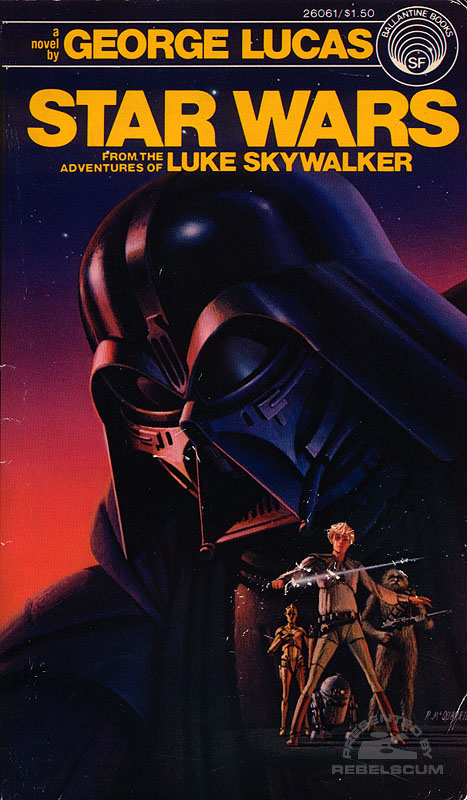
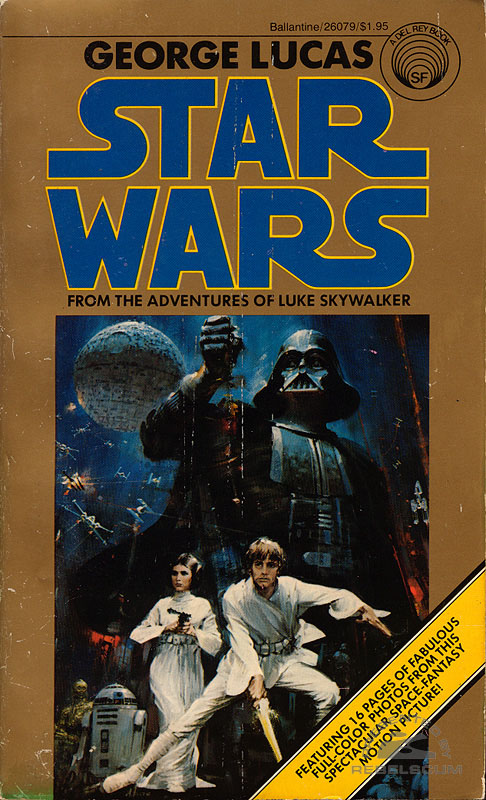
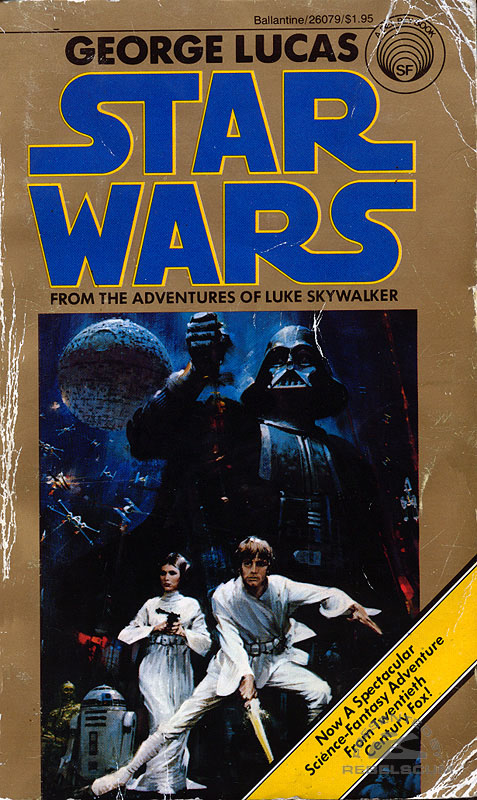
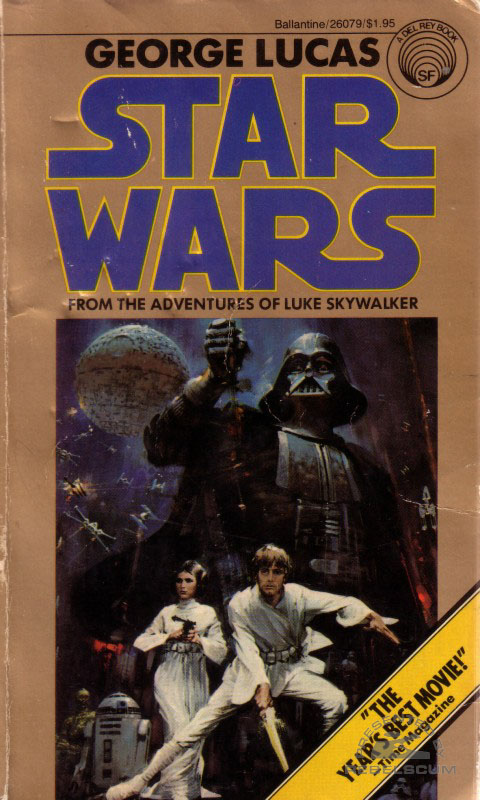
Let's now look at the different versions of this book. The original and first printing from December 1976 featured a Ralph McQuarrie cover with the early versions of Vader, Luke, Chewbacca and the Droids. After this all vintage era covers would feature John Berkey's art.
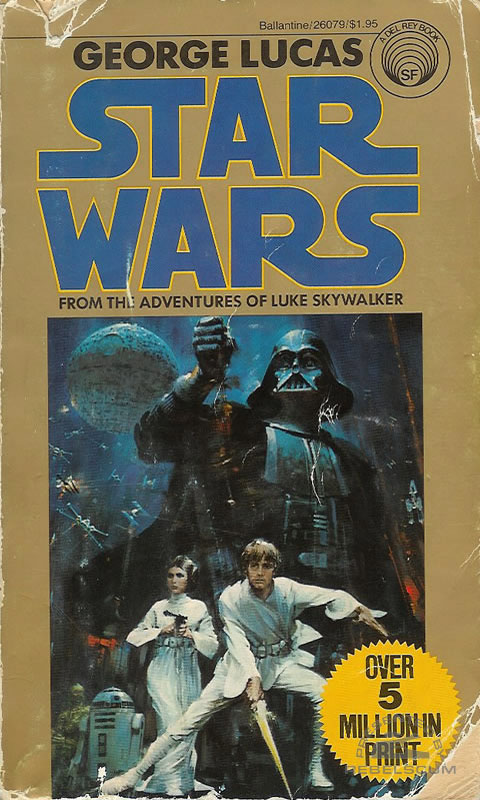
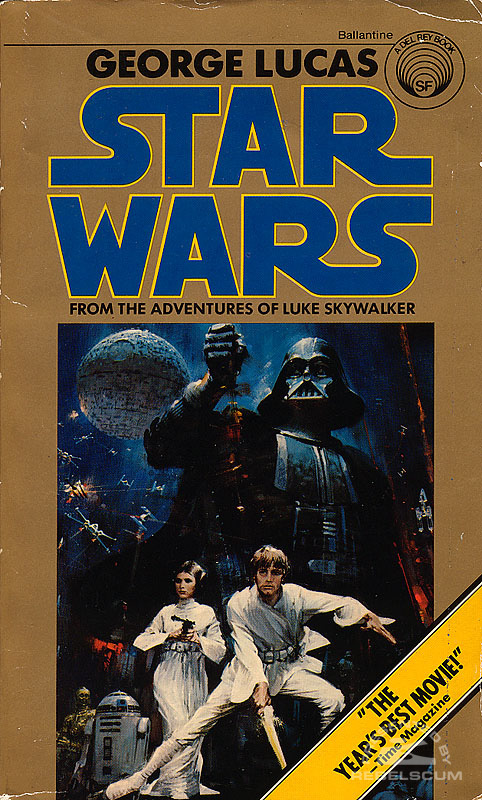
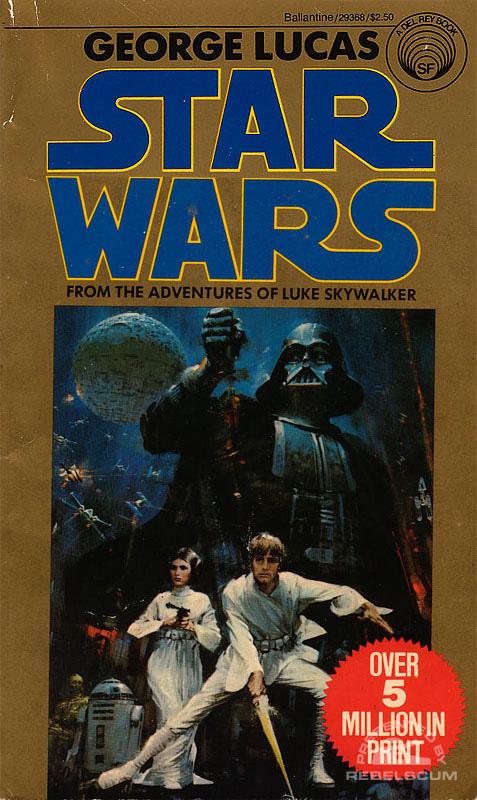
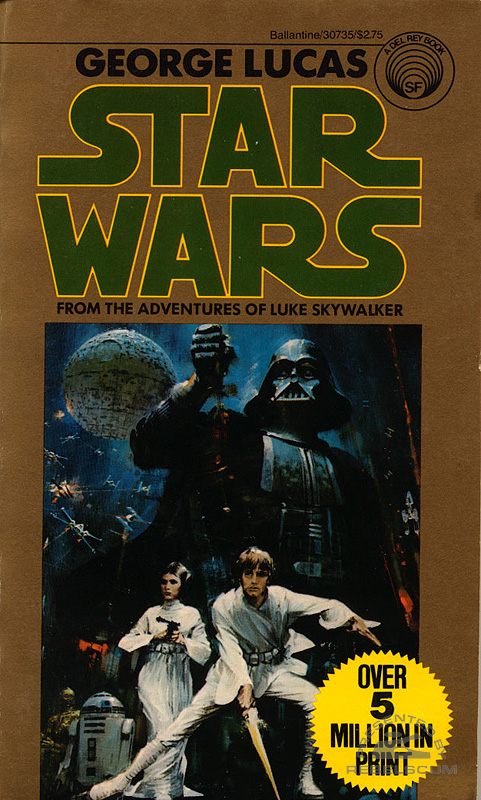
The 2nd thru 21st printings of the book all share similar covers, but there are at least five variations to these. These printings all occurred between 1977 and 1979, while Star Wars was still in release. They can be easily recognized by the all blue Star Wars logo and a yellow stripe or medallion on the cover. Variations of the text on these include one proclaiming "16 pages of full-color fabulous photos" or another telling readers that this novel is "Now a Spectacular Science-Fantasy Adventure".
By the time the 6th printing was out (circa June of 1977 – that's less than 1 month after the film opened!) it was being proclaimed "The Year's Best Movie" by Time magazine on the cover. The 19th printing replaced the stripe with a yellow medallion letting readers know that there are "over 5 million in print." What's interesting is that the 20th printing reverted to the Time Magazine stripe, and looks exactly the same as the 6th printing minus the ISBN and Price in the upper right corner.
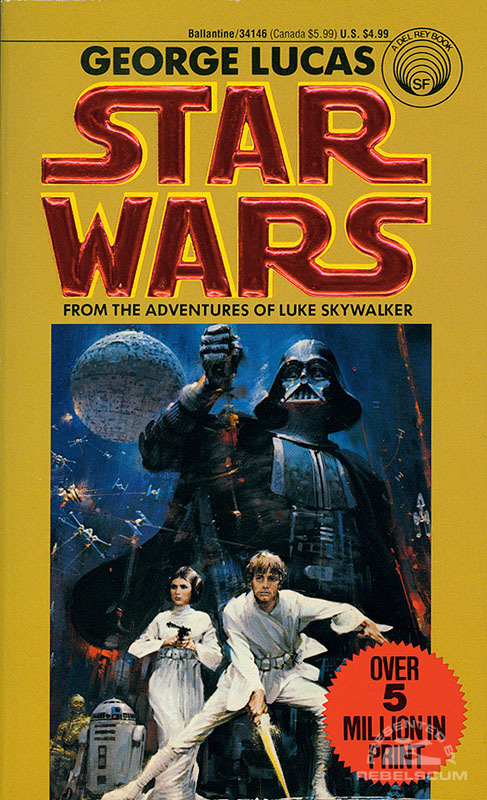
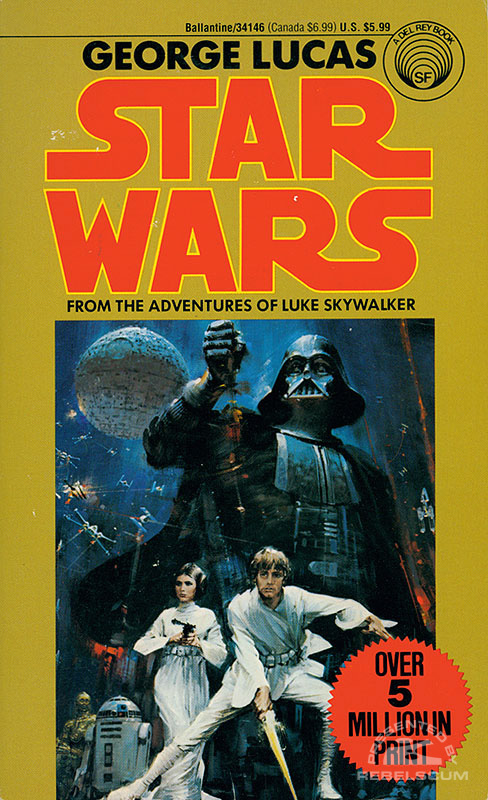
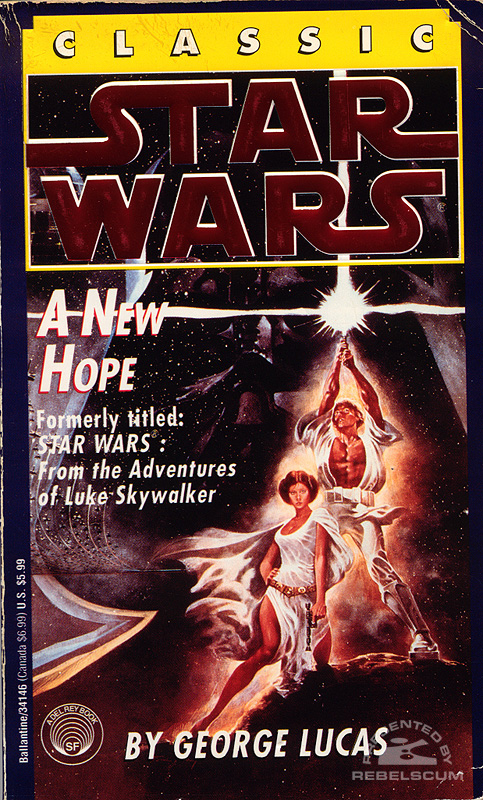
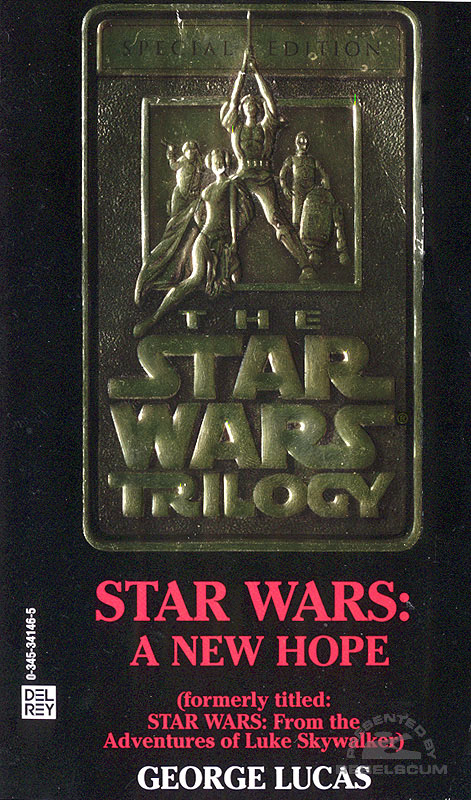
With the release of Empire the Star Wars novel was re-released and had a number of other printings still with a blue Star Wars logo, but now a red medallion proclaimed the 5 million in print factoid. The next variation was a green logo'd version with the yellow medallion, which apparently covered the printings around Jedi and beyond. This covers the 26th to 41st printings.
The early 90's and the resurgence in Star Wars, and the publishing of the first Timothy Zahn novel meant a new cover variation. These editions (42nd-46th) sported red logos and red medallions. Beside a slight price increase, the later of these printings went from an embossed foiled logo to a flat red logo.
1994 brought the first acknowledgment of the now official title, "A New Hope", on the cover and also added the designation of these original stories as "Classic Star Wars" following Dark Horse comics lead with their reprints. This version featured cover art by Tom Jung (based on the original 'A' Sheet poster) and covered the 47th to 52nd printings.
1997 introduced the Special Editions of the films, and while no changes were made to the text of the book, we did see a new Gold Ingot cover based on the Special Edition one-sheet poster. This handled the 53rd to 59th printings.
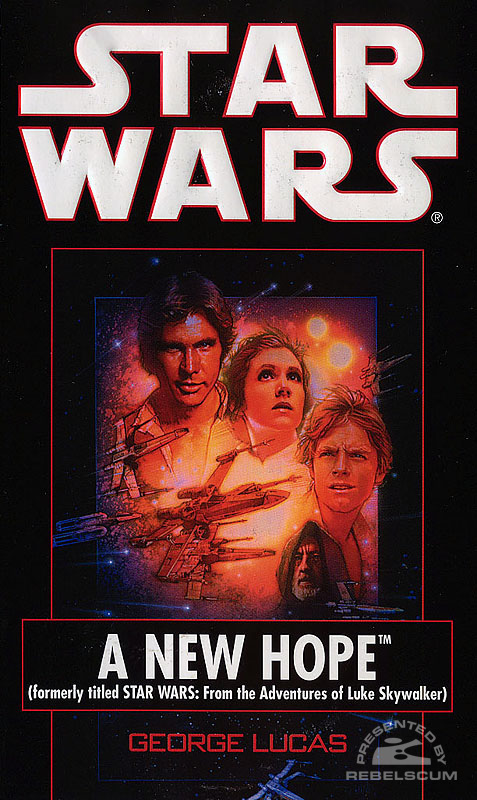
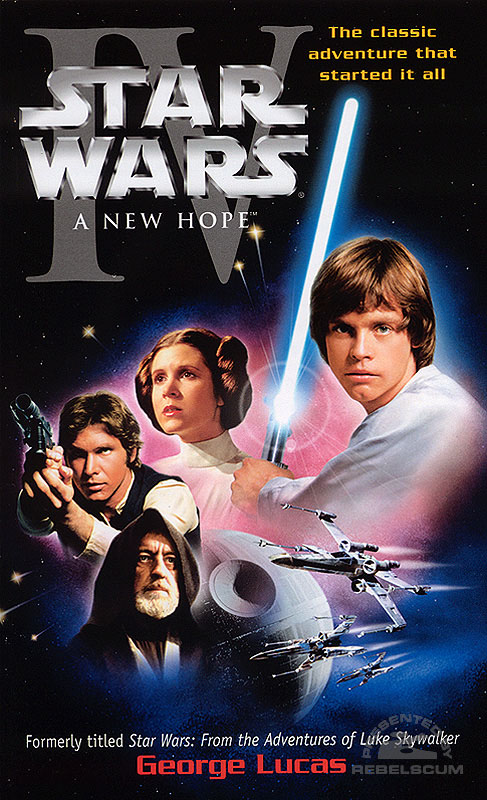
With the release of The Phantom Menace, Del Rey released the 60th edition of the Star Wars novel, this time featuring the A New Hope Special Edition poster art by Drew Struzan, but with reversed artwork from one-sheet.
Most recently with the release of the Star Wars trilogy on DVD, the A New Hope DVD art cover graces the 64th printing and higher.
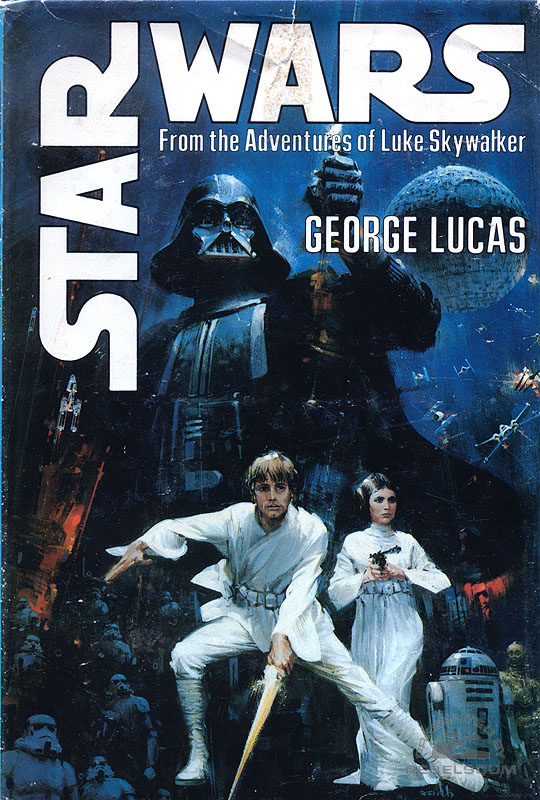
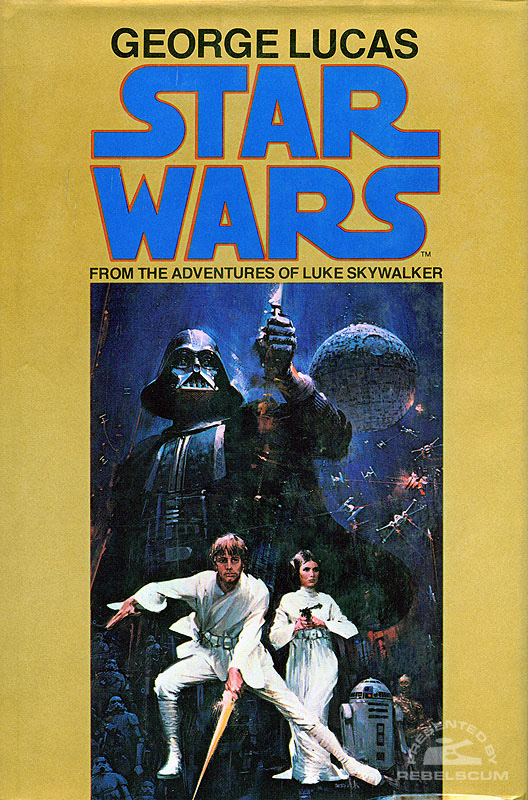
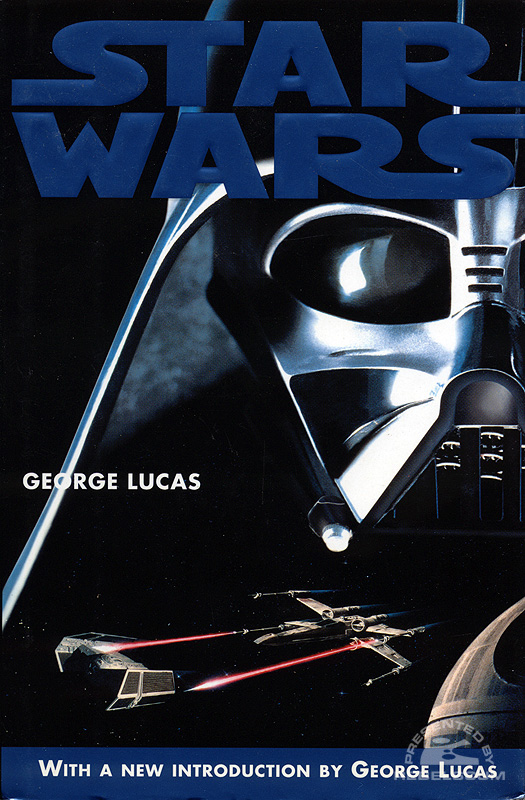
But these listings only cover the mass-market paperback editions of this novel. Let's give some love to the fans of the hardcover. Unlike the current releases of books, where a hardcover edition will precede a paperback edition (sometimes by as much as a year), Star Wars worked differently. As mentioned earlier the paperback came out in December of 1976, and it wasn't until November of 1977 that readers were able to see the hardcover edition. It sported the Berkey art (reversed from its presentation on the paperback editions) and featured a gold border on the dust jacket.
This original hardcover book itself is black underneath the dust jacket. The description of the physical book itself is important since there was also a Science-Fiction Book Club edition. It featured the same Berkey art (reversed as well, on a full bleed dust jacket) but the SFBC book itself was grey. Nowhere does the SFBC edition identify itself as such, except on the back inside flap of the dust jacket. In the world of online auctions, it's important to know which edition you are bidding on, especially if your edition is missing the cover.
The next hardcover edition was published in 1995 as part of the "last time on video" promotion for the films. It features the video cover art from the 1995 release and contains a new forward by George Lucas.
Finally the last, and latest versions of the novel to speak about are the collected editions or bind-ups (the industry term for individual books combined it a larger tome). These editions include the text from all the Classic Trilogy films in one book or box set.
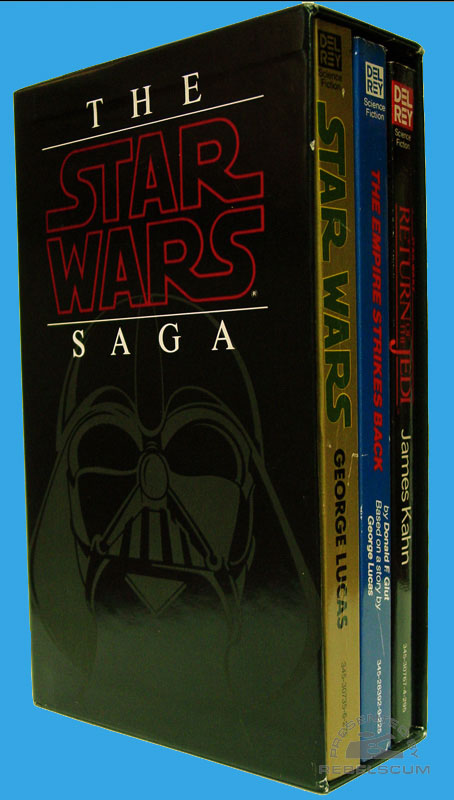
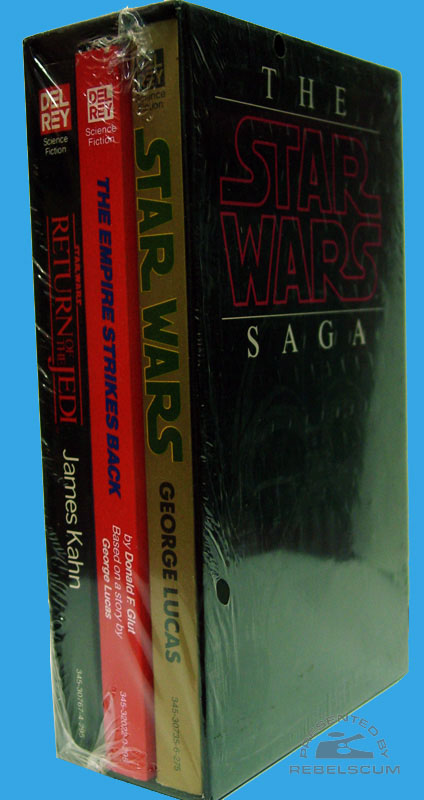
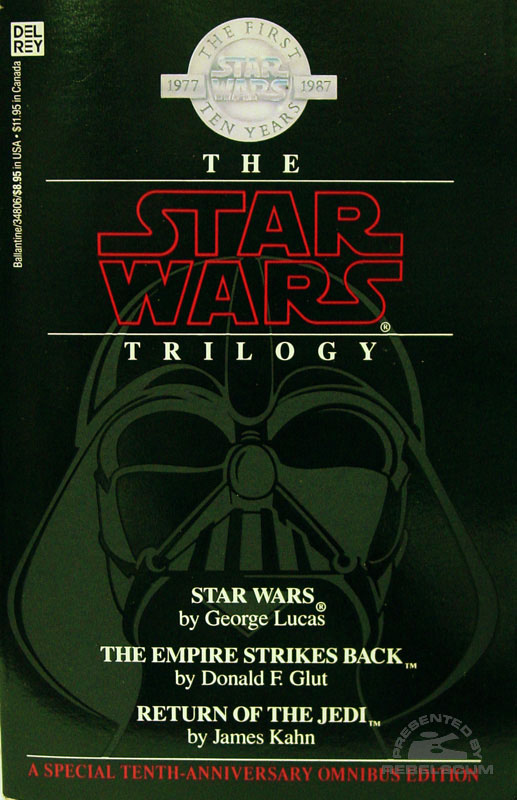
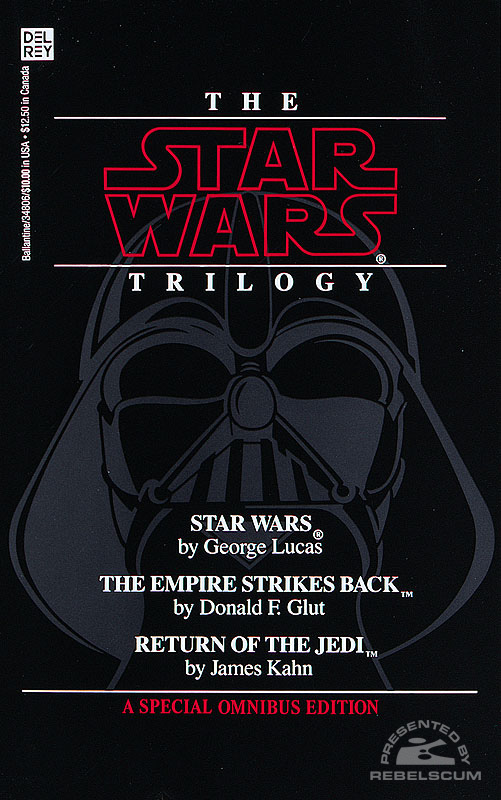
The first is a boxed set of the novels, released shortly after Return of the Jedi. There were at least two variations of this set, one with a blue cover on Empire, one with a red.
Then as part of the 10th Anniversary celebration in 1987, Del Rey released The Star Wars Trilogy Tenth Anniversary Omnibus which features a Vader graphic on the cover by Sylvain Michaelis. This edition contains the text of all three film adaptations (by Lucas, Glut and Kahn) and comes in an edition with the 10th Anniversary logo and one without. It is also a slightly larger paperback size called trade paperback size. These editions make up the 1st thru 8th editions.
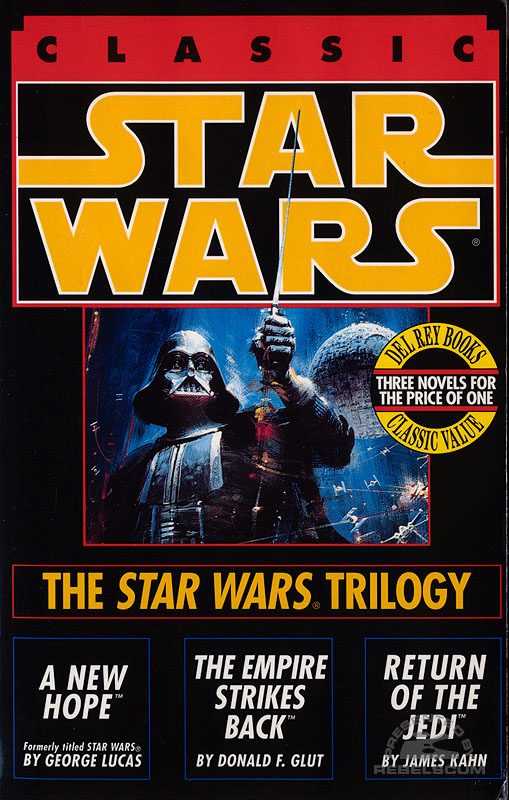
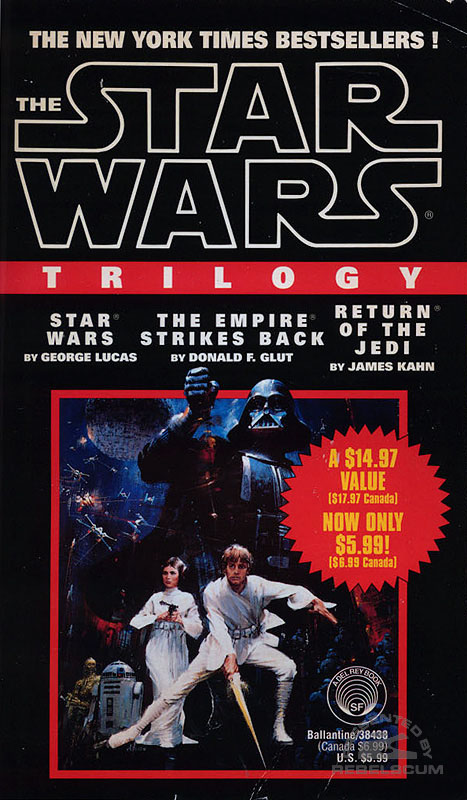
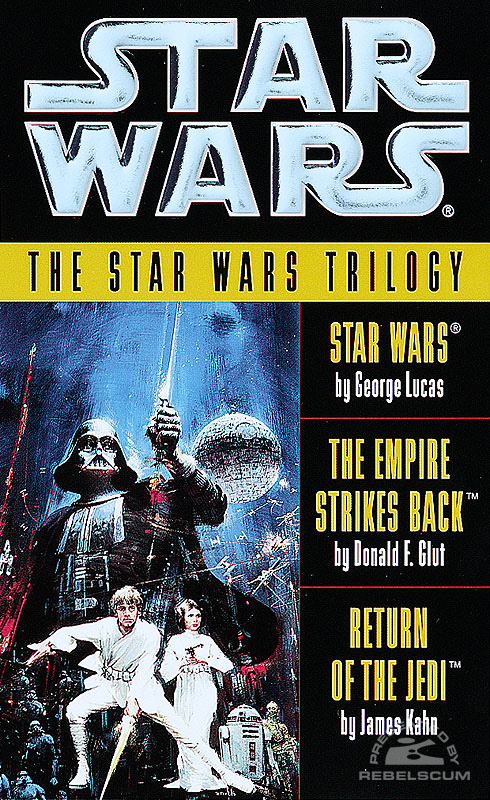
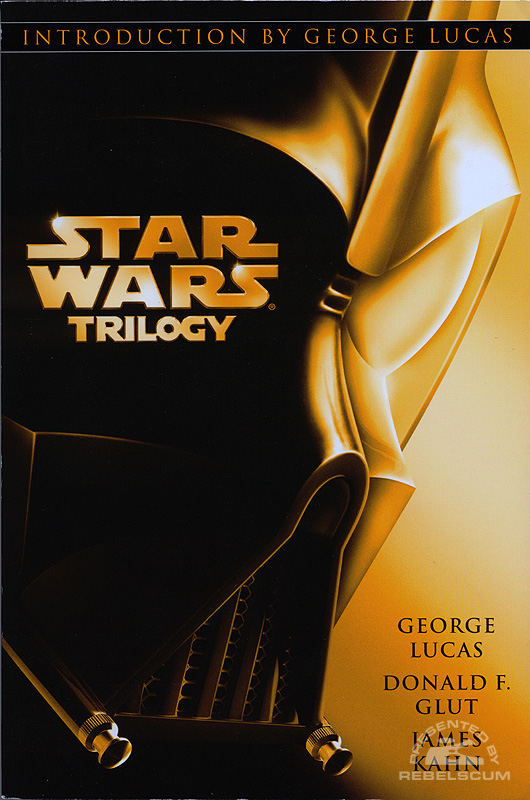
The 9th printing of this bind-up came out in the late 1980's, also in trade paperback, but now under the Classic Star Wars banner. The cover art now featured Vader from the Berkey art. It also had a hardcover edition that was either produced through the Science-Fiction Book Club or as a library edition.
1993 saw yet another new edition of the bind-up, this time reduced to paperback size and proclaiming a $14.97 value for only $5.99. Still called the Star Wars Trilogy, the cover designed was revamped to show more of the Berkey art. This is the red-stripe edition of the book, as it has a red-stripe highlighting the word Trilogy on the cover.
Later in the 1990's the cover would be altered yet again, this time with a yellow-stripe and include even more of the Berkey art. This is the current cover for the bind-up which is in at least it's 29th printing.
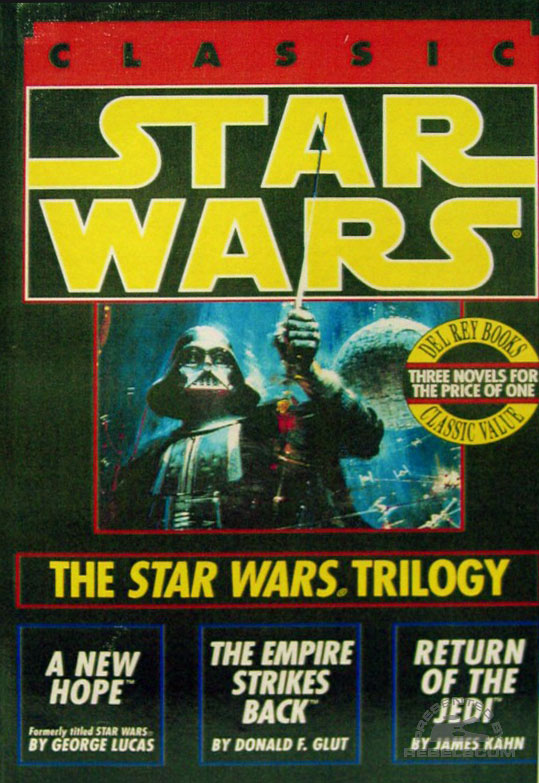
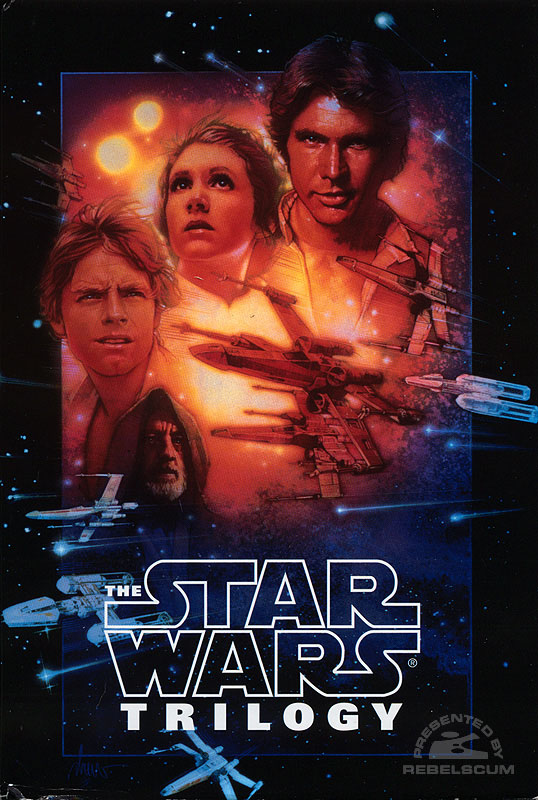
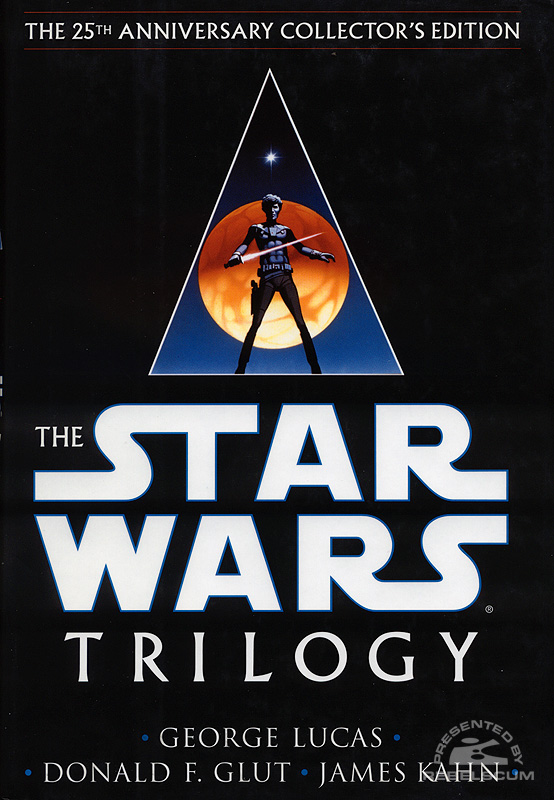
As with the original novel, hardcover editions of the Trilogy book followed. In celebration of the Special Editions, the Science-Fiction Book Club created a hardcover edition circa October, 1997 which featured the Struzan Special Edition poster art. Then in June of 2002, for the 25th Anniversary, Del Rey released the "Collector's Edition" featuring the original McQuarrie triangle artwork on the dust jacket.
Lastly, in honor of the 2004 DVD release, the Star Wars Trilogy was once again released in a trade paperback format, this time with the Gold Vader artwork from the DVD box set.
For more information on the various editions of the Star Wars novel, please be sure to visit the Classic Trilogy section of the Jedi Journals.
 Thirty years ago, 17 pages of comic book would cost you 30¢. For that price you might be getting the latest super-hero adventure or perhaps a pulp detective story. What readers were not expecting was an adaptation of a new sci-fi/adventure film.
Thirty years ago, 17 pages of comic book would cost you 30¢. For that price you might be getting the latest super-hero adventure or perhaps a pulp detective story. What readers were not expecting was an adaptation of a new sci-fi/adventure film.
In those days, films were not marketed in comic books. Comics were not the industry that they have become since, and were looked down on as kiddie books. But obviously George Lucas had an idea of how to market his film, and was reminded of his love for those pulp action/adventure comics of old, such as the titles from EC Comics.
Contacted by Lucasfilm's representative, Charles Lippincott, Marvel Comics was approached to produce the film adaptation. Roy Thomas, who was at the time the scribe for Conan the Barbarian and Fantastic Four was asked to write, while Howard Chaykin was asked to do the art. "George had seen my work on Cody Starbuck and liked it," says Chaykin. "I guess he saw a lot of Han Solo in that character."
So with the writer and artist on board, Lippincott gave them a copy of the script, some black and white production stills and the McQuarrie portfolio. Chaykin was amazed at Ralph's designs for the film, but thought the stills looked "too inert". He still marvels at how much the film came out looking like the production paintings.
For the writing process, Thomas used the novelization to complete the script using various amounts of text from the book to keep the two projects consistent. This, of course, explains the addition of the Biggs and Luke scenes to the first issue of the comic.
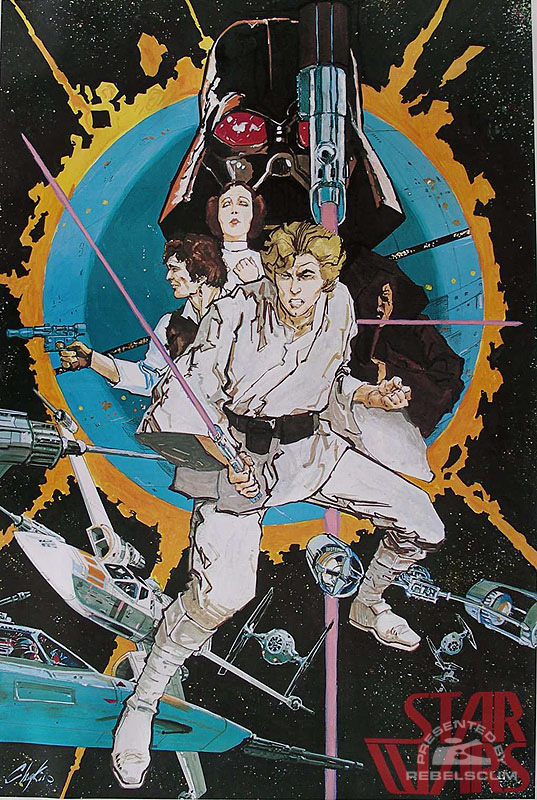
The comic itself was released in February of 1977, having been hyped prior to that, most notably, at the 1976 San Diego Comic Con. Thomas and Chaykin attended this convention to help promote not only the comic, but the movie as well. Chaykin had been asked by Lucasfilm to produce a poster to hype the film. It was supposed to be part of a series, but ended up being the only one. And now its quite a prized collectors item, most recently having been made into a 3D sculpted poster by Code3 Collectibles.
Thomas tells the humorous, and very business-like story that his Marvel circulation editor was trying to get them to reduce the planned six issue adaptation down to one or two issues to help on costs. It seems that Marvel got paid the same amount regardless of how many issues they produced. So the fewer the better. Obviously Thomas won out, but imagine what a one or two issue adaptation would have been like.
Well imagine everybody's surprise when the film opens three months later and the comic was not to be found on the magazine stands. The advance publicity completely sold the book out and reprints were needed, fast! Reprints, which the creators were paid standard wages for. No special contracts for writers and artists in those days. Fifteen dollars per page, per reprint for Chaykin, even less for Thomas. Quite a shame when you consider the dozens of printings this book has undergone.
Looking back on their time, both creators realize the impact of the issue, but are not defined by it. To them it was a job, and not always an enjoyable one. But they seem to understand their place in the Star Wars mythos.
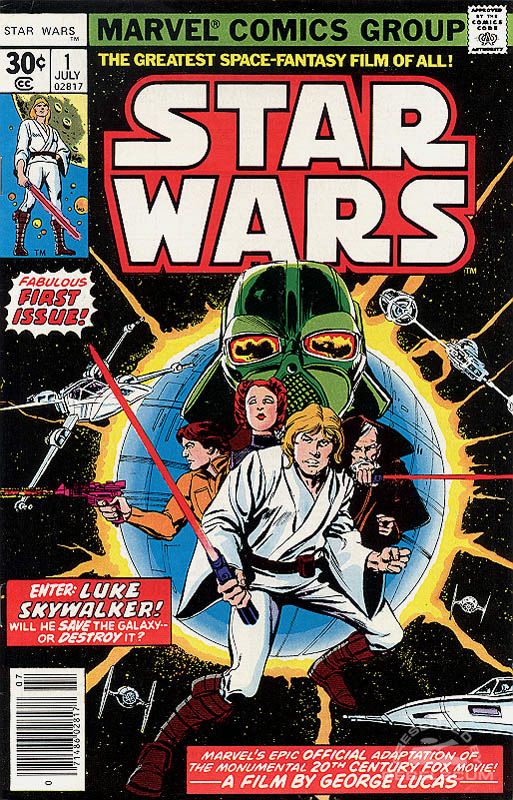
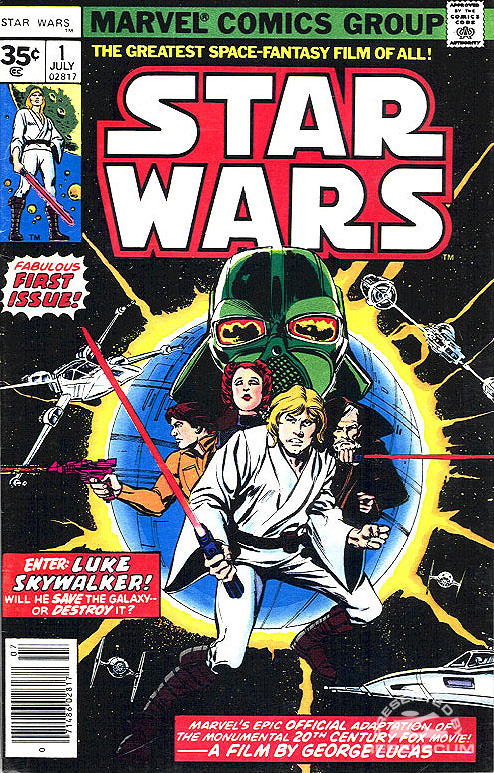
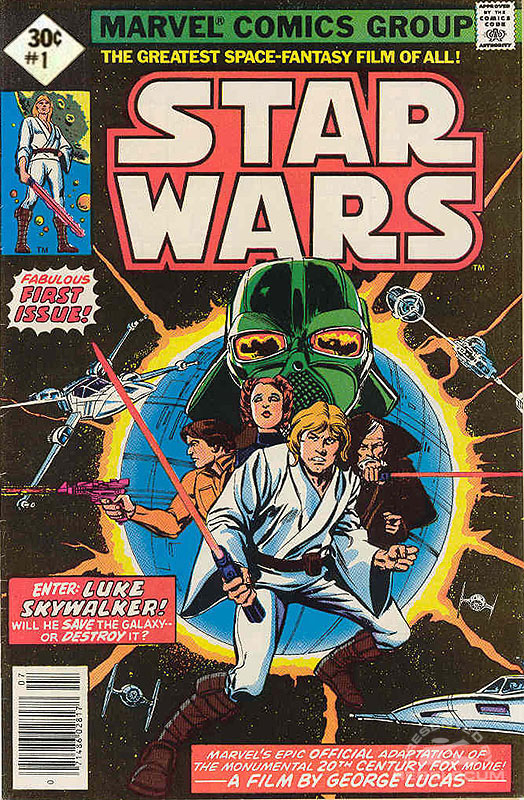
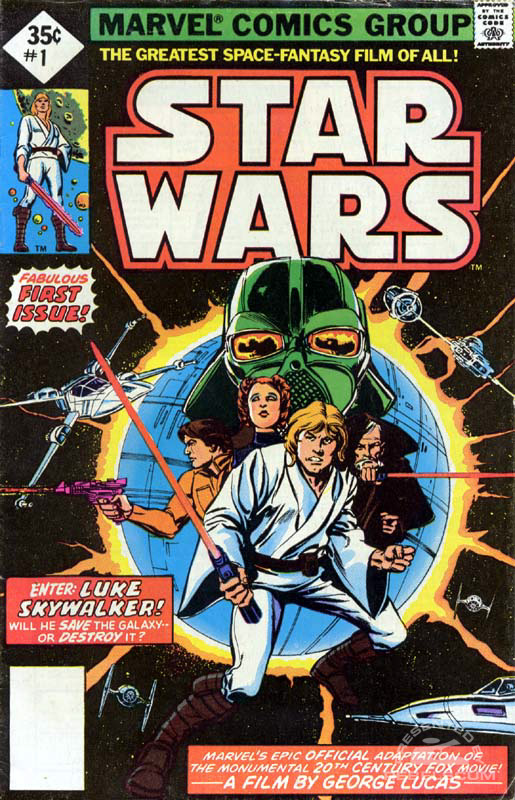
Initially Star Wars #1 was printed with a 30¢ price tag. However, there are a certain number of issues (the rumors say about 1,500) that received limited distribution with a 35¢ cover price. It seems that Marvel was experimenting with a slightly higher price on their books between January and June of 1977, and Star Wars just happened to get one.

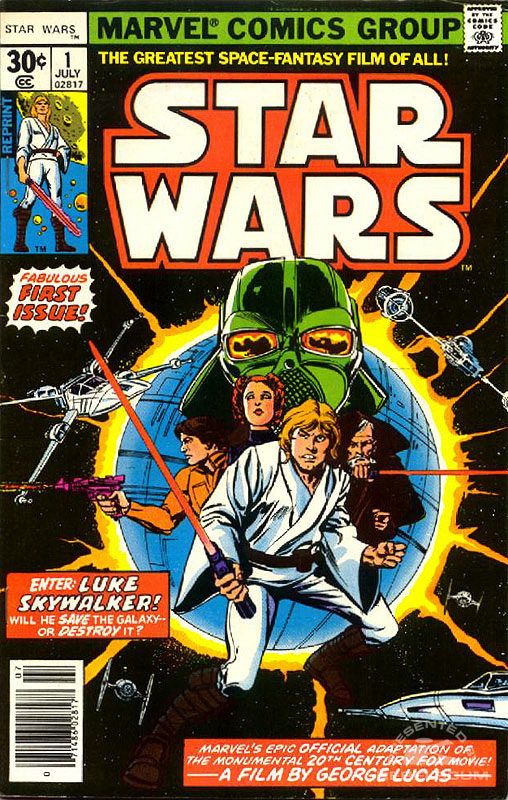
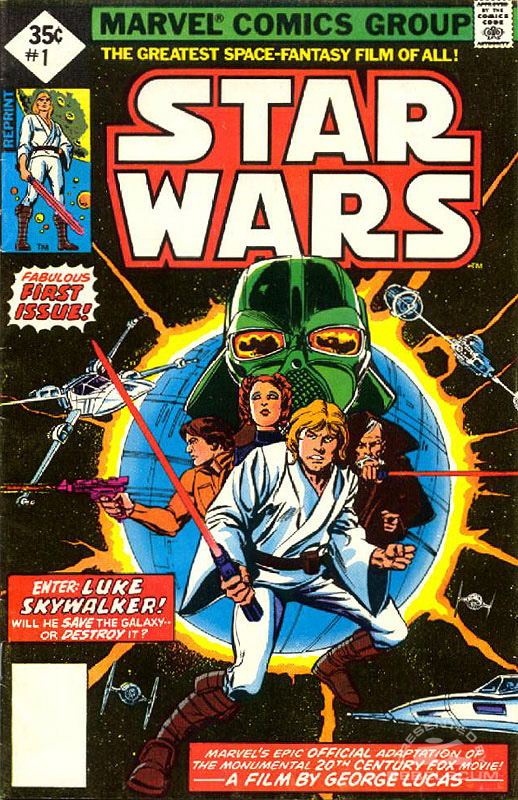
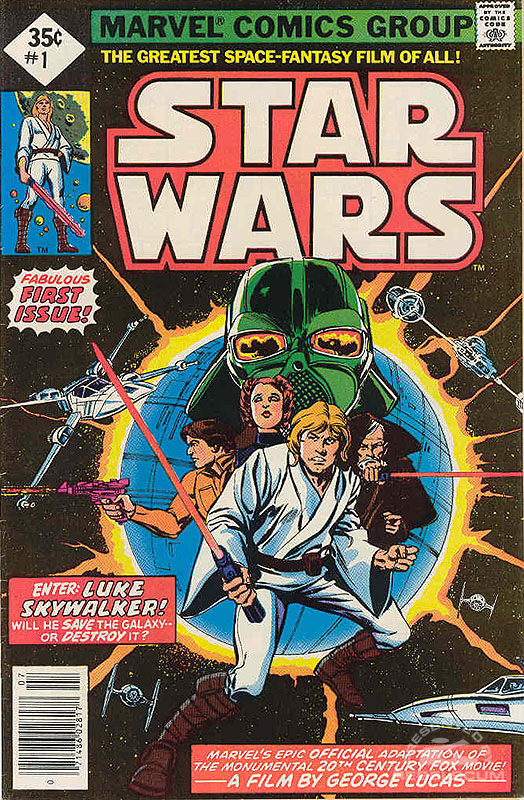
Both the 30¢ and 35¢ issues went into reprints. A reprint of the book has the text "reprint" stamped in the character box in the upper left-hand corner of the comic, while reprint text also appears on the indicia inside.
As if that wasn't enough, different issues can also be found with a diamond surrounding the number and price. This indicates an issue that was sold through the direct market (ie. comic specialty shops) instead of the newsstands. It is not a reprint as many assume, unless it bears the aforementioned "Reprint" text. Both the 30¢ and 35¢ issues exist as direct market and newsstand versions. Some direct market issues will inadvertently have a UPC code (instead of the more common blank white box), and can always be identified by the diamond shape surrounding the price.
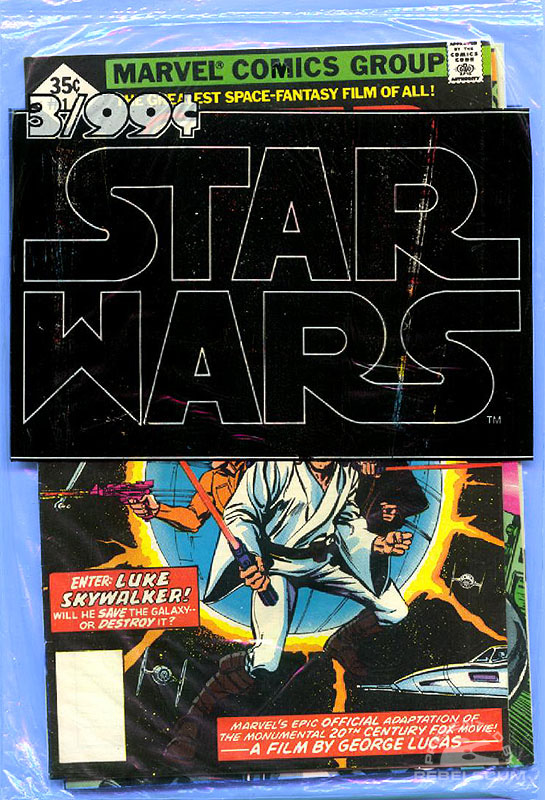
Besides these seven versions of issue #1 that appeared between February 1977 and the end of the year, other variations of this book also exist in a variety of poly-bagged multi-packs. Issues #1-3 were combo packed together for 99¢ by both Marvel and Whitman publishing.
So you have a variety of single issues of the comic, but that's just the tip of the iceberg. Much like the Star Destroyer in the opening minutes of the film, the versions of this issue keep coming and coming.
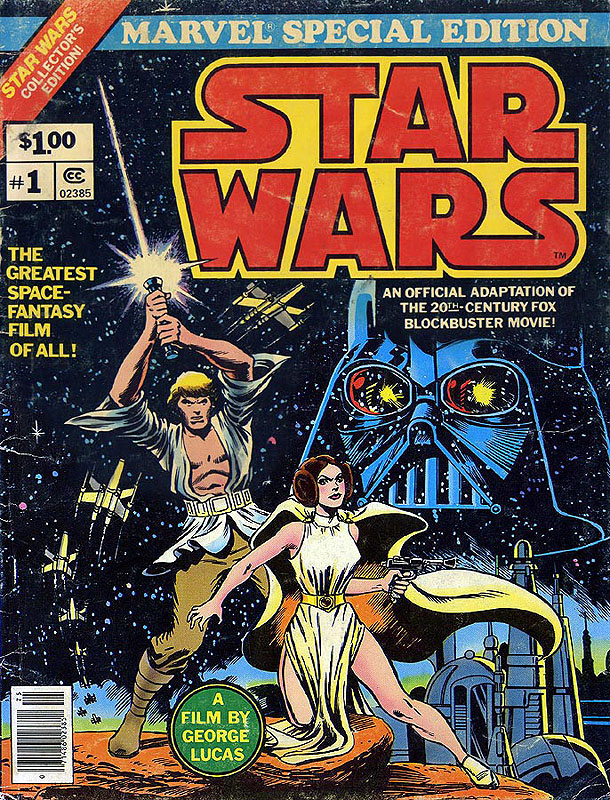
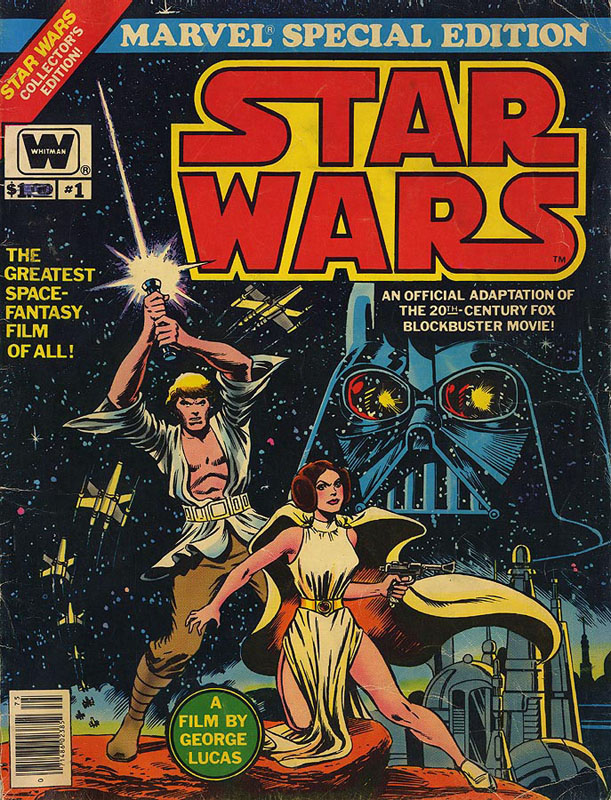
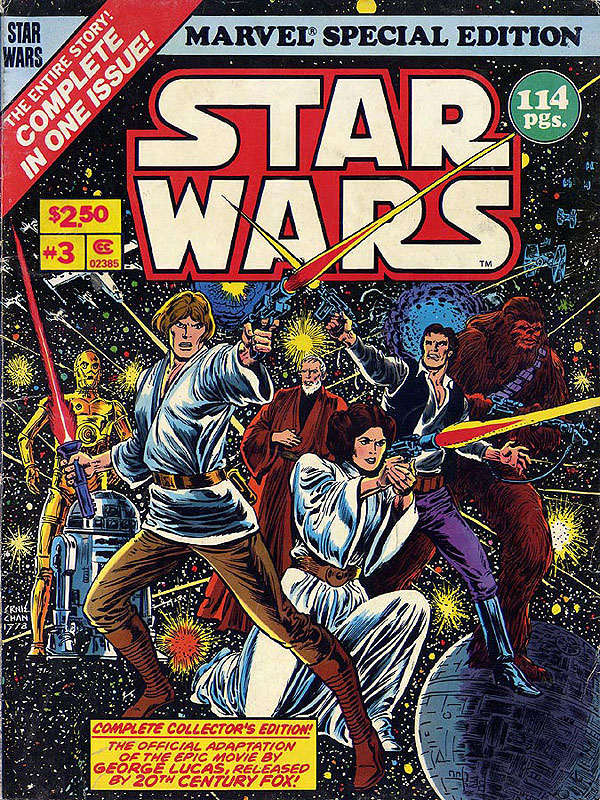
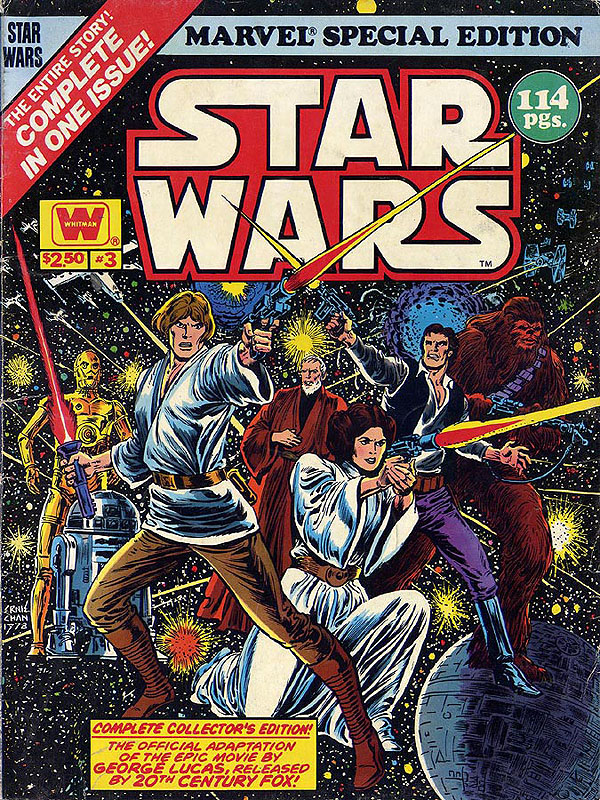
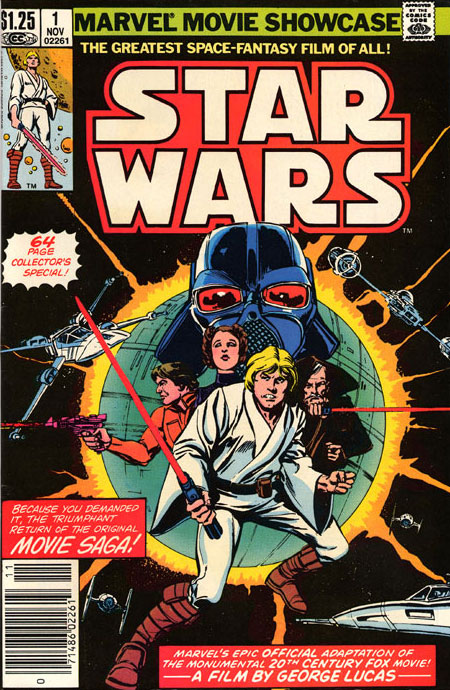
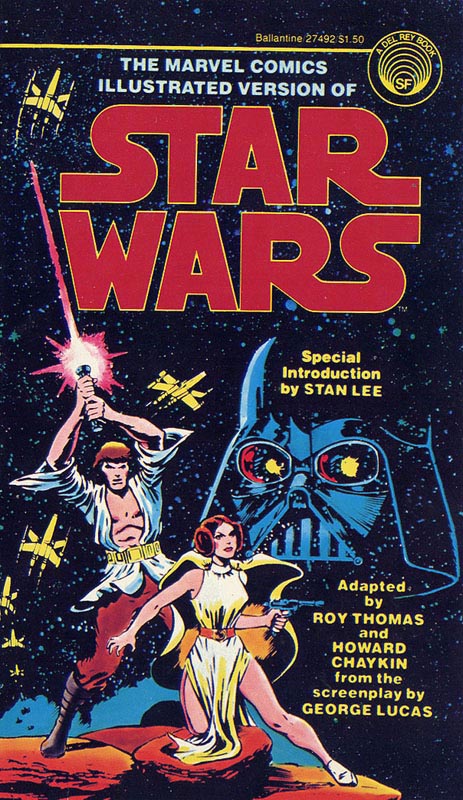
Marvel had a series of over-sized comics called Treasury Editions which reprinted stories from various superhero comics of the time such as Amazing Spider-Man or Marvel Team-Up. Marvel Special Edition #1 reprinted Star Wars #1-3. A few months later Marvel Special Edition #3 reprinted all six issues of the adaptation. Marvel books also published a paperback sized, black and white version of the film in late 1977 which featured the same art from all six issues, but arranged in a format best suited to a mass market paperback.
Time passed and just prior to the release of Return of the Jedi, Marvel re-released the Star Wars adaptations in a pair of higher-quality Mando paper books called Marvel Movie Showcase. Issue #1 as had become the standard, reprinted issues #1-3 of Star Wars.
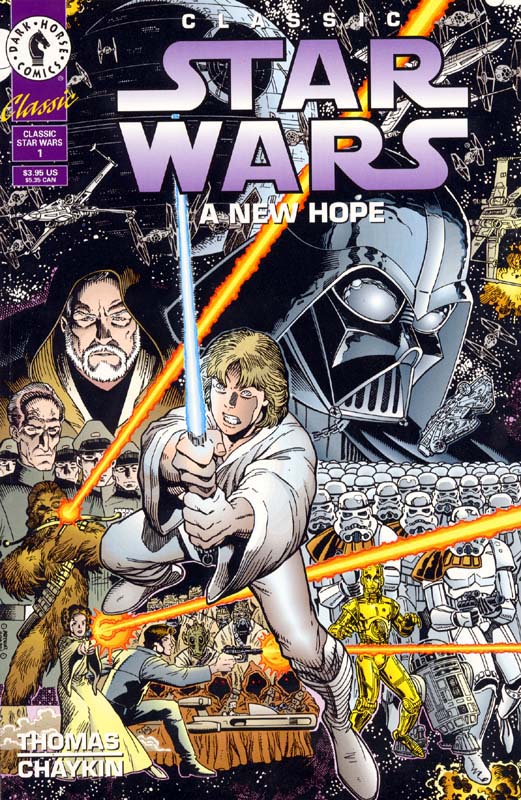
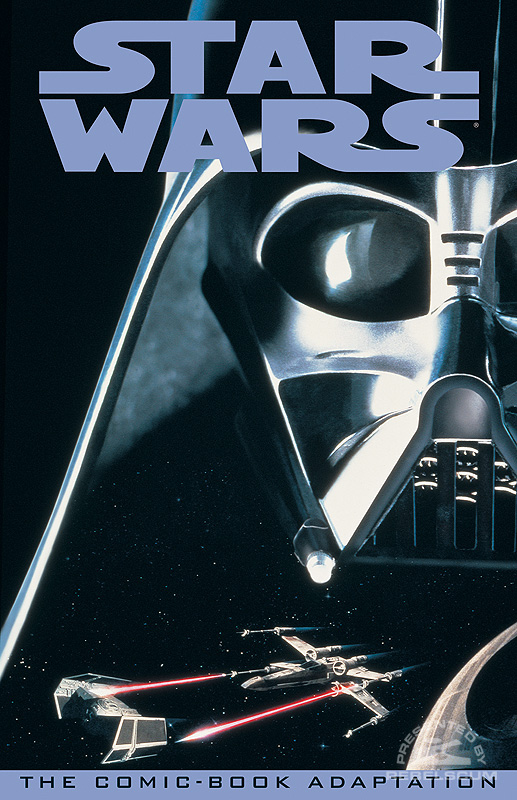
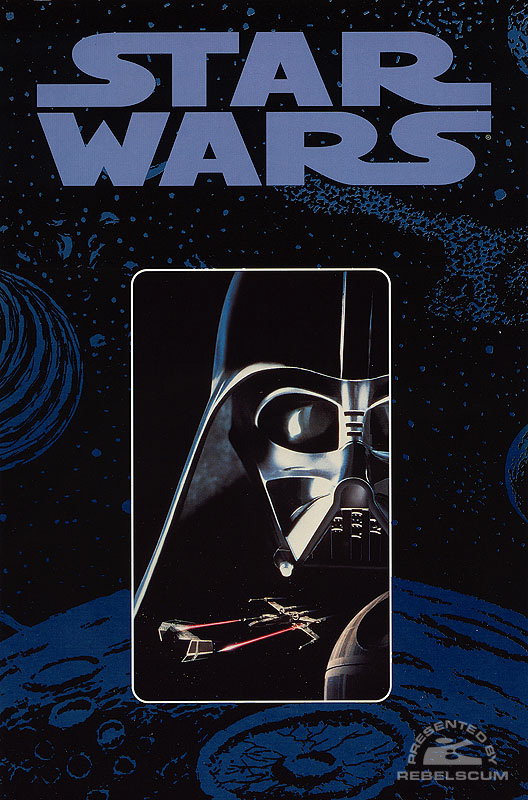
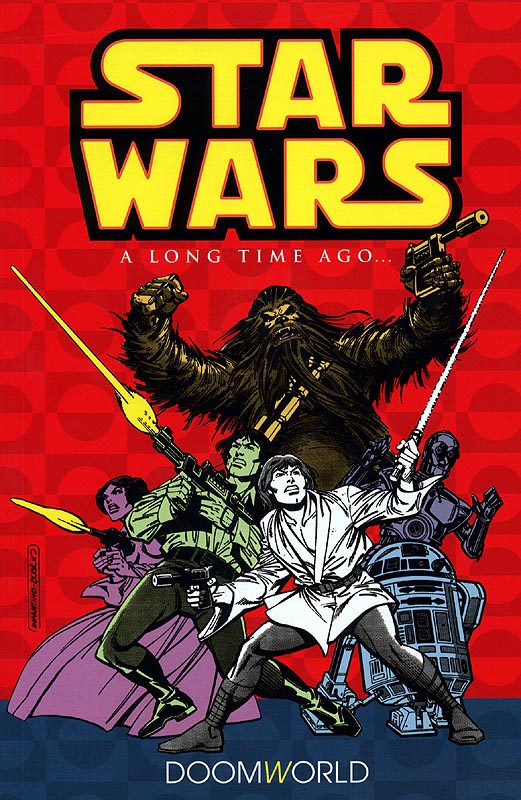
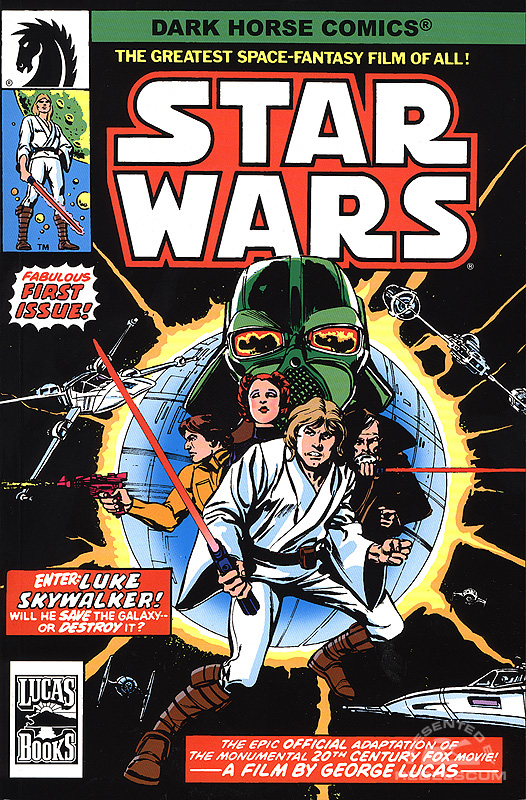
Flash forward now twelve years. Marvel has relinquished the comic license to Dark Horse. Dark Horse begins printing books under the Classic Star Wars banner, and these include a pair of prestige format books, the first one reprinting Star Wars (you guessed it!) #1-3. This time the art has been edited, removing title credits and blurbs, plus it has been recolored to give it a more subdued style, as opposed to the rather garish colors of the Marvel era.
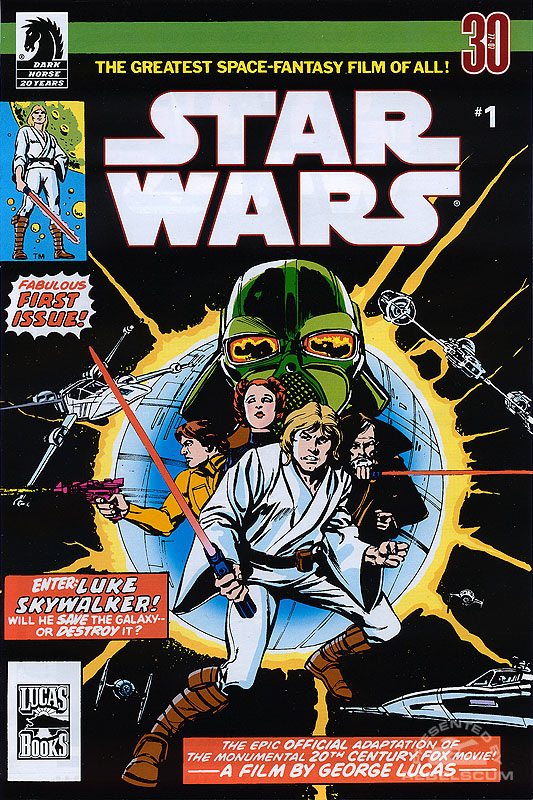
Dark Horse would continue to reprint Star Wars #1 in a single Trade Paperback of A New Hope, as it was now called. The trade paperback was released as a single issue as well as part of a box set of all three film adaptations. Dark Horse even went so far as to reprint all of the Marvel comics, and issue #1 showed up in the first Trade Paperback of the series, "Doomworld".
Other recent editions of issue #1 include the Hasbro Expanded Universe Comic Two-Packs #2, which features a Darth Vader and Rebel Soldier figure colored in the style of the Marvel comics, as well as another Trade Paperback of the film included in the Wal*Mart A New Hope unaltered 1977 theatrical edition on DVD from September of 2006.
For more information on this Marvel comic issue, please visit our entry at the Jedi Journals.
Where will we go from here? Well, since this is just the first 30 years of Star Wars, who's to know what is to come. But if history gives any clue, this story will be around for generations to come. Star Wars IS forever!
 Alan Dean Foster (author)
Alan Dean Foster (author)Besides being the author of the Star Wars novels Splinter of the Mind's Eye and The Approaching Storm, he has also written dozens of other novels, including other film adaptations such as Aliens, Chronicles of Riddick and the soon to be released Transformers (and it's prequel novel Ghosts of Yesterday), as well as original works that include his Commonwealth series and the Flinx & Pip series, of which his final novel Flinx Transcendent should be done shortly.
Ralph McQuarrie (cover artist)
Fans of Ralph's artwork can look forward to a new book from dreams & visions press featuring artwork from the Star Wars films as well as many other projects, from film, television, and commercial art. Attendees to Celebration IV in Los Angeles, will have the opportunity to purchase two McQuarrie prints from his designs for Star Wars.
John Berkey (cover artist)
John Berkey has continued his art career, producing another iconic image, that of the Old Elvis Stamp circa 1993. In 2004 he was inducted into the Society of Illustrators Hall of Fame, which includes Norman Rockwell, N.C. Wyeth, and John James Audubon. One of his original concept pieces for Star Wars sold for $5000 at the "John Berkey Observed" show in Northfield Minnesota. Most recently this longtime South Lake Minnetonka resident has been honored by the city of Excelsior, Minnesota which proclaimed March 22 John Berkey Day.
Roy Thomas (scripter, editor)
Roy Thomas continued his writing career thru Marvel and DC Comics writing titles such as All-Star Squadron, Thor and West Coast Avengers. He is currently editor of the comic magazine Alter-Ego for TwoMorrows Publishing and has his own take on the 30th Anniversary of the Star Wars Franchise in issue #68.
Howard Chaykin (Illustrator, cover pencils)
Howard Chaykin has continued his comic art career since 1977 working on such titles as American Flagg for First Comics, The Shadow for DC and is currently working on the Blade monthly for Marvel, plus an upcoming Wolverine, the interior art for Punisher #50, and a two-issue Batman/Catwoman story for Brave & Bold at DC Comics.
Jim Novak (letterer)
Jim Novak has continued lettering issues of comics for Marvel regularly since 1977 including Spider-Man, Daredevil, Fantastic Four and Wolverine.
Marie Severin (colorist)
Marie, a veteran of comic books has continued to color comics since Star Wars, including ALF, Incredible Hulk, Superman Adventures, and Doctor Strange.
Tom Palmer (cover inker)
Tom continued inking issues of Star Wars, and was the series regular between #49 and #94. He also penciled four issues of the original Marvel series. He also worked on Star Trek & Adventures of Superman for DC and Ghost Rider and X-Men for Marvel.
Special thanks to Alan Dean Foster, Roy Thomas, Howard Chaykin, John Jackson Miller and Pete Vilmur for their assistance in gathering the necessary materials, quotes and reflections to write this article.


